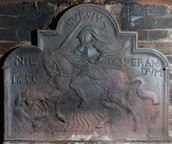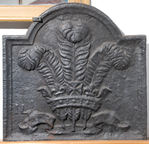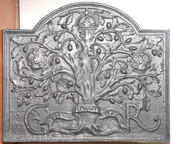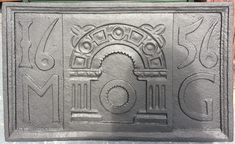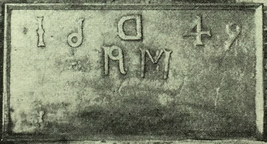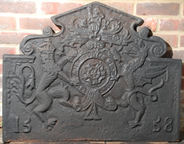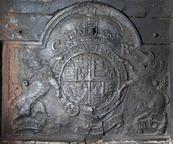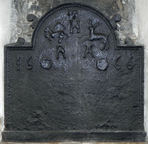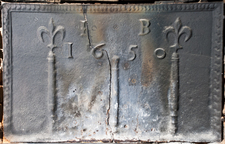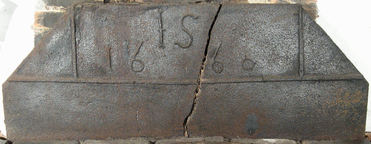-
657
Description: Rectangular with curved top corners; Arched rectangular extension on top; ovolo edging; mounted figure in 17th cent. armour riding down a dragon to the left and below, sword in hand; inscription across top and either side of horseman; date below left; initials below right.
Notes: Probably a representation of St George and the Dragon, with political undertones, given the date. Cursius may be a mis-spelling of Marcus Curtius, who sacrificed himself for the good of Rome. Nil Desperandum - Despair not. Other firebacks also bear the initials, IM, which probably relate to the pattern maker, some with a similar style of lettering.
Copies of this fireback are known.
Inscription: CVRSIVS / NIL DESPERANDVM / 1650 / IM
- Decoration tags:
- rectangular with round arch (shape)
- ovolo (edging)
- whole carved pattern
- pictorial
- allegorical
- text
- animals
- humans
Manufactured: in 1650 possibly at Brede Furnace in the Weald area of England.
Current location: in private hands, Rolvenden, Kent, England.
- Attached to series:
- IM series
- Hooked '1' series
- Brede group
-
670
Description: Arched rectangular shape; cavetto edging; three ostrich feathers issuing from a royal coronet; a blank motto banner below; the initials bottom left, above banner.
Notes: The badge of the Prince of Wales; perhaps cast during the Commonwealth period. A copy personalised with added initials.
Copies of this fireback are known.
Inscription: IL
- Decoration tags:
- rectangular with round arch (shape)
- cavetto (edging)
- whole carved pattern
- individual letters
- heraldic
- text
Manufactured: in the mid-17th century in the Weald area of England.
Current location: Rottingdean Grange, The Green, Rottingdean, East Sussex, England.
(part of the Brighton Museum museum group)
- Attached to series:
- Prince of Wales firebacks
- Small cavetto series
-
679
Description: Arched rectangular shape; cavetto moulding all round; spreading oak tree, with leaves and acorns, filling the whole plate; three royal crowns, one at the top of the tree, the other two symmetrically on the ends of branches towards the top corners; initials CR towards the bottom corners, the remaining inscription on a scroll across the base.
Notes: The design is derived from the celebrated occasion when Charles II evaded his pursuers by hiding in an oak tree at Boscobel House, near Wolverhampton, following the final Royalist defeat at the battle of Worcester in 1651. This popular fireback has been copied frequently.
Copies of this fireback are known.
Inscription: C THE ROYALL OAK R
- Decoration tags:
- rectangular with round arch (shape)
- cavetto (edging)
- whole carved pattern
- heraldic
- pictorial
- historical
- text
- plants
Manufactured: in the mid-17th century in England.
Current location: Saffron Walden Museum, Saffron Walden, Essex, England.
Museum number: 1899-2 (part of the Saffron Walden Museum museum group)
Citation: Butterfield, W. R., 19 Jan 1935, 'Charles II Fireback', Hastings and St Leonards Observer.
Citation: Butterfield, W. R., 1916, 'Old Wealden Firebacks', The Connoisseur, 46, pp. 197-209.
- Attached to series:
- Commemorative firebacks
-
1099
Description: Rectangular shape; ovolo-moulded edging; raised central rectangular panel with inset stylised design of a rounded arch upon Ionic columns, the inside edge indented; at quarter angles outside the arch, two trefoils; within the arch, sequence of linked hollow strapwork rhomboids and circles; between the columns, a roundel with the internal edge indented; left of the central panel, 16 above upper-case M in low relief; right of the central panel, 56 above upper-case G in low relief.
Notes: An unusually small but well-preserved back with a stylised design. The style of the numerals, particularly the 6 and 5, can be seen on a larger fireback of 1653.
Copies of this fireback are known.
Inscription: 16 56 / M G
- Decoration tags:
- rectangular (shape)
- ovolo (edging)
- carved stamps
- whole carved pattern
- individual letters
- individual numbers
- architectural
- text
Manufactured: in 1656 in the Weald area of England.
Current location: Avery Way, Tamar View Industrial Estate, Saltash, Cornwall, England.
- Attached to series:
- Date & initials firebacks
- 1650s Wealden series
-
1098
Description: Rectangular shape; indeterminate moulded edging; central initials (A? D M)in triad, between split date (6 reversed).
Notes: The characters have been derived from an odd assortment: the numbers appear to be a recognisable character set, with the 6 and 9 interchangeable, although 6 has been inadvertently reversed; the 6/9 has also been used, with the same stamp as has been used to form the uprights of the M, to construct a probable capital A (or R); the nature of the stamps forming the M is unclear. Noted in 1939 at Palfrey Farm, near Petworth, West Sussex, which from the mid-16th century had been home to the Penycod family, suggesting that the fireback had not been original to the house.
Inscription: 16 / A[?] D M [triad] / 49
- Decoration tags:
- rectangular (shape)
- indeterminate moulded (edging)
- simple stamps
- carved stamps
- text
Manufactured: in 1649 possibly at Frith Furnace, Northchapel in the Weald area of England.
Current location: not known.
Citation: Smail, H. C. P., Apr 1939, 'Iron Firebacks' [letter], Sussex County Magazine, 13, 4, p. 284.
- Attached to series:
- Date & initials firebacks
- Petworth lettering series
-
682
Description: Rectangular, with detached pediment joined by mirrored S-shaped scrolls; fillet edging with scalloping on inside edge (top and sides of rectangle, and pediment, only); central Tudor rose with surrounding garter, crowned lion and dragon supporters, surmounted by a helmet, mantling and crowned lion passant crest; initials, ER, separated by crest; initials, TP, in top corners of rectangle; ‘date’ split between bottom corners.
Notes: Stylistically of the late 16th or very early 17th centuries, the date is absent from some versions, and is likely to have been added spuriously to later recastings, of which this is one, the style of the numerals being identical to a series of firebacks cast in 1648-58.
Copies of this fireback are known.
Inscription: E R / T P / 1558
- Decoration tags:
- rectangular with detached pediment (shape)
- scalloped fillet (edging)
- whole carved pattern
- individual numbers
- heraldic
- royal
- text
Manufactured: in the mid-17th century possibly at Tintern Furnace in the Forest of Dean area of Wales.
Current location: in private hands, Sedlescombe, East Sussex, England.
- Attached to series:
- Miscellaneous royal firebacks
- 1640-50s Dean series
-
350
Description: Arched rectangular shape; cavetto edging; armorial; Stuart English royal arms within a circular garter; crown, motto and supporters (crowned lion and unicorn); initials separated by crown.
Notes: An early casting of a widely copied fireback. A later copy with an inserted, probably spurious, date is no. 1303.
Copies of this fireback are known.
Inscription: C R / HONI SOIT QVI MAL Y PENSE / DIEU ET MON DROIT
Arms: English Stuart royal
- Decoration tags:
- rectangular with round arch (shape)
- cavetto (edging)
- whole carved pattern
- armorial
- royal
- text
Manufactured: in the mid-17th century in England.
Current location: Knole, Sevenoaks, Kent, England.
(part of the National Trust museum group)
- Attached to series:
- Carolean royal armorial firebacks
- Stuart royal armorial firebacks
-
974
Description: Arched rectangular shape on a plain plinth; scalloped cavetto-moulded edging (top and sides); initials in triad within arch; date split in top corners; unidentified stamp top centre; hound stamp above letter 'R', stag stamp above letter 'A'; annulet stamp repeated inside each half of the date; flat scrolled protuberance on each side of arch; smaller protuberance above each shoulder.
Notes: The initials are likely to be those of a husband and wife, the stag and hound possibly associated with the husband's occupation. The protuberances are seen in different forms on few firebacks of the same period.
Inscription: RHA / 16 66
- Decoration tags:
- rectangular with round arch (shape)
- scalloped cavetto (edging)
- carved stamps
- individual letters
- individual numbers
- text
- animals
- objects
Manufactured: in 1666 in England.
Current location: Bishop's House, Norton Lees Lane, Sheffield, South Yorkshire, England.
(part of the Museums Sheffield museum group)
- Attached to series:
- Miscellaneous stamp firebacks
- Date & initials firebacks
- Loop edged firebacks
-
1285
Description: Rectangular; ovolo-moulded, gadrooned edging (top and sides); lower centre, a vertical spindle between two vertical spindles of a different form each surmounted by a fleur-de-lys; the date split by the top of the middle spindle; the initials above the first two and last two figures of the date.
Notes: The gadrooned style of edging is a distinctive feature of this group of firebacks, the style of fleur-de-lys being observed on two other backs within the group.
Inscription: I B / 1 6 5 0
- Decoration tags:
- rectangular (shape)
- gadrooned (edging)
- simple stamps
- carved stamps
- individual letters
- individual numbers
- heraldic
- text
- objects
Manufactured: in 1650 possibly at Cuckfield Furnace in the Weald area of England.
Current location: in private hands, Waltham St Lawrence, Berkshire, England.
- Attached to series:
- Spindle series
- Spindle/distaff firebacks
- Date & initials firebacks
-
690
Description: Canted rectangle; plain edges; broad horizontal fillet dividing the plate in two just above the side angles, with vertical fillets to top corners enclosing date and initials.
Notes: Uncharacteristically crude for the period.
Inscription: IS / 16 60
- Decoration tags:
- rectangular with canted top corners (shape)
- none (edging)
- simple stamps
- individual letters
- individual numbers
- text
Manufactured: in 1660 in the Weald area of England.
Current location: Smallhythe Place, Small Hythe Road, Tenterden, Kent, England.
Museum number: 1117951 (part of the National Trust museum group)
- Attached to series:
- Date & initials firebacks
